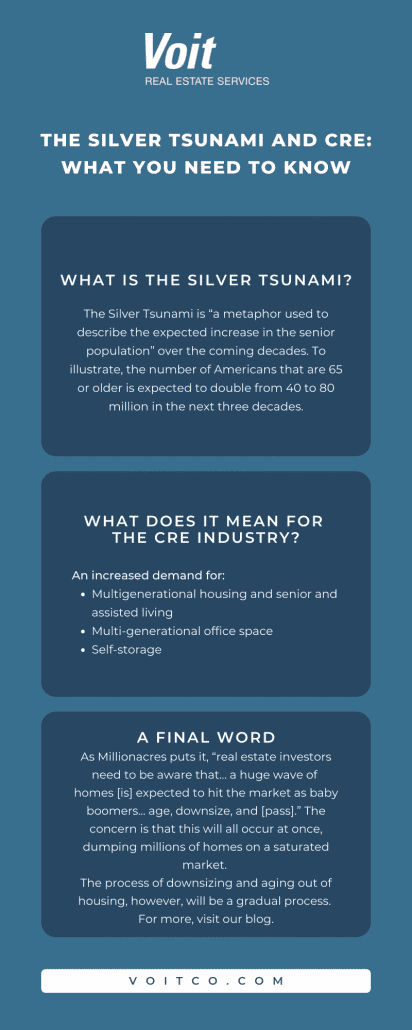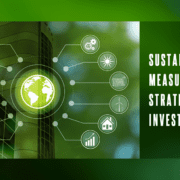The Silver Tsunami and CRE: What You Need to Know
Today, 15% of Americans are 65 or older. In the next three decades alone, however, this number will jump from 40 to 80 million. What does this mean for the workplace, housing, and for the commercial real estate industry writ large? So what effect will the Silver Tsunami have on Commercial Real Estate (CRE), let’s dive in?
The Silver Tsunami: Defined
So, before we dive into the Silver Tsunami and what it means for commercial real estate, what is it? Simply put, the Silver Tsunami is “a metaphor used to describe the expected increase in the senior population” over the coming decades.
An additional 40 million seniors will be “relying on Medicare, using the healthcare system, and seeking senior living,” according to Leisure Care. The baby boom, which ended in 1964, brought a wave of changes to schools, to the workforce and to America as a whole, now, as those baby boomers become seniors, we can expect advertising and the structures of society to focus on meeting the needs (and addressing the desires) of this aging population.
While many seniors may not appreciate the term “Silver Tsunami,” it attempts to illustrate the impact that the increase in the senior population will have not only on the commercial real estate industry but on the nation at large; considering one out of every five Americans will be 65 years old or older by the year 2030, according to the government agency of San Diego County.
More on This Generation
You might be wondering, why are there so many seniors advancing in age anyway? Well, this is a result of the baby boom. Baby boomers, according to Pew Research Center, include individuals who were born between 1947 and 1964.
Today, baby boomers make up approximately one-third of the United State’s population. In fact, 10,000 baby boomers turn 65 years old every day. (This factors out to nearly seven people per minute!) All this considered, it makes sense as to why this generation has been associated with the term “Silver Tsunami.”
The “Silver Tsunami… What Does it Mean for Commercial Real Estate?
So, now that we’ve covered what the Silver Tsunami is, let’s dive into what this phenomenon means for the commercial real estate industry.

Multifamily Property
In the coming years, as a wave of individuals retires and downsizes, the commercial real estate industry will observe an increased demand for multigenerational housing and senior and assisted living.
Although many people associate apartment living with younger generations like Millennials and Gen Zers, Baby Boomers account for more multifamily housing than you might think. In fact, an article by IMS shares that “Boomers actually account for more than half of US rental growth in the past decade.”
Looking to the future, by 2030, the number of renters (who are 65 or older) is expected to double!
But what types of properties is this generation looking to settle into? And where? A recent Freddie Mac survey finds that “eight out of ten boomers actually prefer to be in an urban area throughout their retirement.”
Long gone are the days of building out large, suburban retirement communities.
Urban environments allow flexibility for travel, benefits including “city-life, such as a walkable community, cultural activities, dining and shopping, parks, and libraries.” Moreover, “this generation also prefers amenity-rich communities… in other words, resort-style living.”
Boomers, additionally, want to live close to their children and grandchildren amidst finding a stable community to be a part of, as put by Lee Brennan, principal at Cuningham Group Architecture. Urban environments typically help achieve these desires.
Office Space
In the office today, we are observing a large melting pot of different generational cohorts. Millennials, Generation Z, baby boomers, the list goes on.
But when it comes to the office, baby boomers aren’t budging, even despite their advancing age.
This generation is known for having a strong work ethic, having been raised among war and recession. Additionally, baby boomers are the first generation who will live lengthier lives than previous generations which means they will likely work longer. In fact, this generation, it seems, is staying at work longer than other generational cohorts.
Even post-retirement, many boomers pick up a second career to stay busy. In other words, boomers aren’t leaving work any time soon—which presents a challenge for management teams as far as office space goes.
Today, the open office is growing in popularity. As a result, companies are faced with the challenge of designing multi-generational office space—space that meets the varying needs and expectations of each demographic.
Baby boomers, as you can imagine, are accustomed to having more personal space whereas younger generations are used to working in highly open, collaborative environments.
As a result of the Silver Tsunami, the demand for multi-generational office space will continue to swell over the coming years and is something to be considered as business owners assess their company’s space needs today and into the future.
Self-Storage
As the time to retire approaches, individuals often downsize and move to apartments or condominiums that are nearly half the size of their previous residency. Looking forward, however, this doesn’t mean that boomers will thin out their belongings as a result.
In the coming years, we anticipate many boomers to turn to self-storage units. This is a solution that will allow boomers to house generations of heirlooms, belongings they intend to pass down, furniture, and so on—not to mention luxuries that might include collectibles, art, cars, RVs, etc. as a result of inheritances, long-term investments, and more.
Looking forward, as a result of the Silver Tsunami, we can anticipate the demand for self-storage units and property to increase.
As the Silver Tsunami Passes
In time, the inevitable, of course, will occur. As Millionacres puts it, “real estate investors need to be aware that… a huge wave of homes [is] expected to hit the market as baby boomers—people born between 1946 and 1964—age, downsize, and [pass].”
“I can see why some analysts are concerned by the so-called ‘Silver Tsunami,’” says Andrew Latham, certified personal finance counselor and managing editor of SuperMoney. After all, as Millionacres says, “the total inventory of homes owned by boomers and pre-boomers is worth around $13.5 trillion, or 75% of the U.S. annual economic output.”
The concern is that this will all occur at once, dumping millions of homes on a saturated market. The process of downsizing and aging out of housing, according to Millionacres, however, will be a gradual process.
A Final Word
According to projections by The U.S. Census Bureau projects, U.S. history will be made by 2035 when the number of seniors outnumbers youth for the first time ever.
The term “Silver Tsunami” attempts to illustrate this project and the impact that it will have not only on the commercial real estate industry but on the nation at large.
The fact of the matter is that over the years many CRE properties will be added to the market as a result of aging seniors selling.
The specifics of how things take shape, however, depend widely on individual markets. This might include supply and demand, mortgage rates, and specifically where this aging demographic wants to reside in retirement and on. In other words, things might look very different in California than say, in the smallest state of the 50 states, Wyoming.
We do know, however, that the following generations’ relationship with homeownership will set the tone for investment and local markets following.









